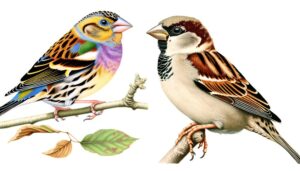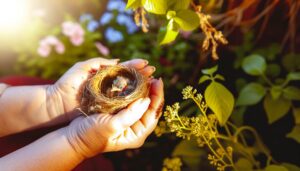5 Simple Steps to Get a Baby Sparrow to Open Its Mouth
To get a baby sparrow to open its mouth, start by making sure it's in a warm environment, maintaining a temperature of 95-100°F using a heat pad or lamp. Inspect the sparrow for injuries and signs of dehydration.
Once the bird is comfortable, gently tap the side of its beak with a soft object, being careful not to apply too much pressure. Do this during daylight when it's more alert.
Ensure the surroundings are quiet and low-traffic to reduce stress. Use a sterilized dropper for feeding, offering protein-rich, moist food, like specialized baby bird formula.
To find in-depth procedures and tips, continue exploring further.
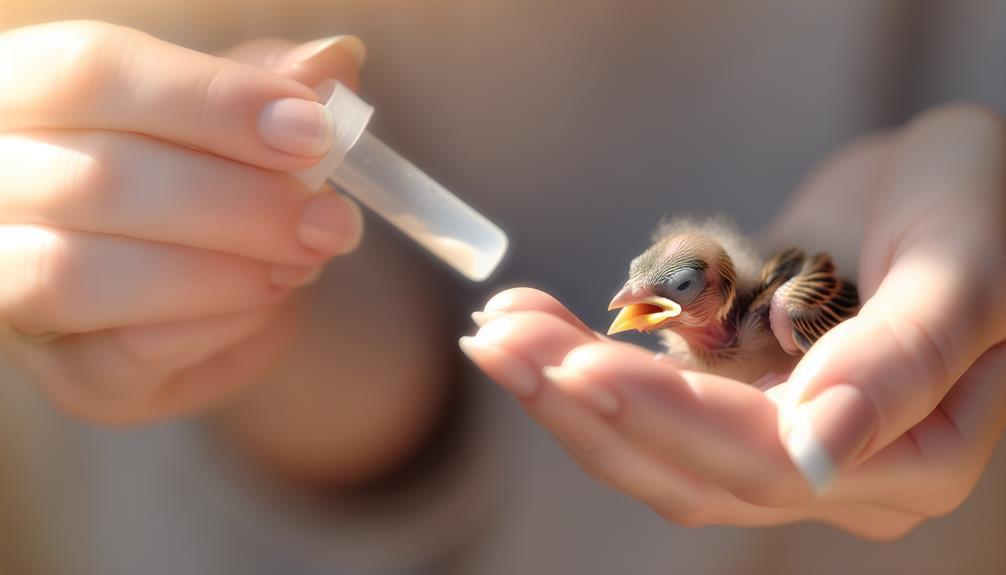
Key Takeaways
- Tap the side of the beak gently with a soft object to encourage opening.
- Offer a small drop of water on the tip of the beak to stimulate a response.
- Use a gentle, consistent tapping method during daylight hours for better results.
- Ensure a calm and quiet environment to minimize stress and encourage feeding behavior.
- Position food close to the beak to entice the baby sparrow to open its mouth.
Assess the Sparrow's Condition
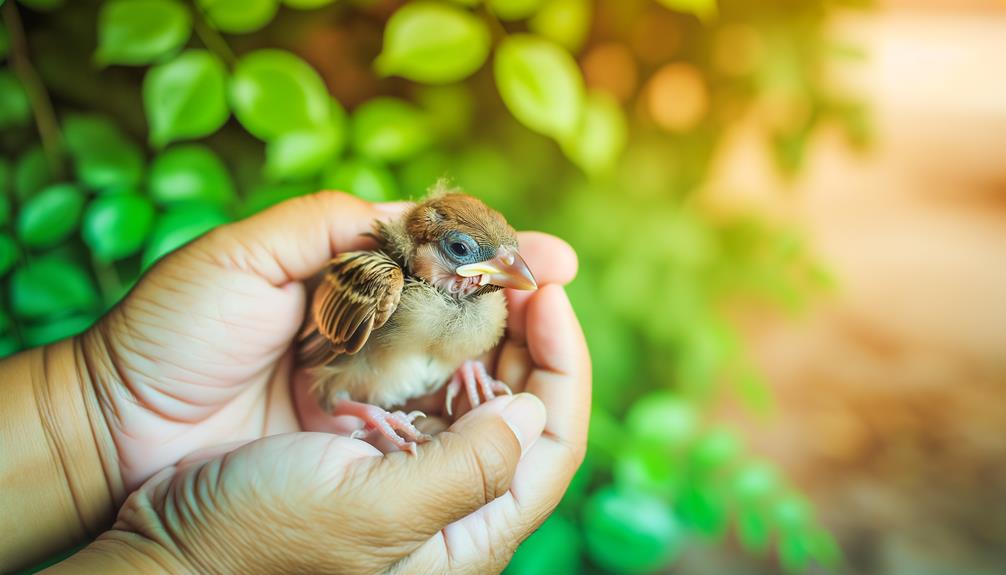
Before attempting to feed the baby sparrow, closely examine its physical condition to determine if it's injured, dehydrated, or in shock. Start by gently inspecting its wings, legs, and beak for any visible injuries.
Look for signs of dehydration such as wrinkled skin or sunken eyes. Check its breathing pattern; rapid or labored breathing could indicate shock. Also, observe its behavior—if it's lethargic or unresponsive, it might need immediate veterinary care.
Use a small flashlight to check its mouth for obstructions or abnormalities. Evaluate if the bird is warm to touch, as hypothermia can exacerbate stress. By thoroughly evaluating its condition, you'll be better equipped to provide the appropriate care and improve its chances of survival.
Create a Safe Environment
Ensure the baby sparrow's enclosure mirrors its natural habitat by providing warmth, soft bedding, and minimal disturbances. Securing a safe environment is vital for the bird's well-being and encourages it to open its mouth for feeding.
Here's a detailed checklist to help you:
- Temperature Control: Maintain a consistent, warm temperature using a heating pad or lamp.
- Soft Bedding: Use paper towels or tissue to create a soft, nest-like surface.
- Enclosure Size: Choose a small box or container that limits movement but allows comfort.
- Quiet Area: Place the enclosure in a low-traffic area to reduce stress.
- Sanitation: Clean the enclosure regularly to prevent infections and maintain a healthy living space.
This approach fosters a stress-free environment conducive to feeding.
Warm the Baby Sparrow
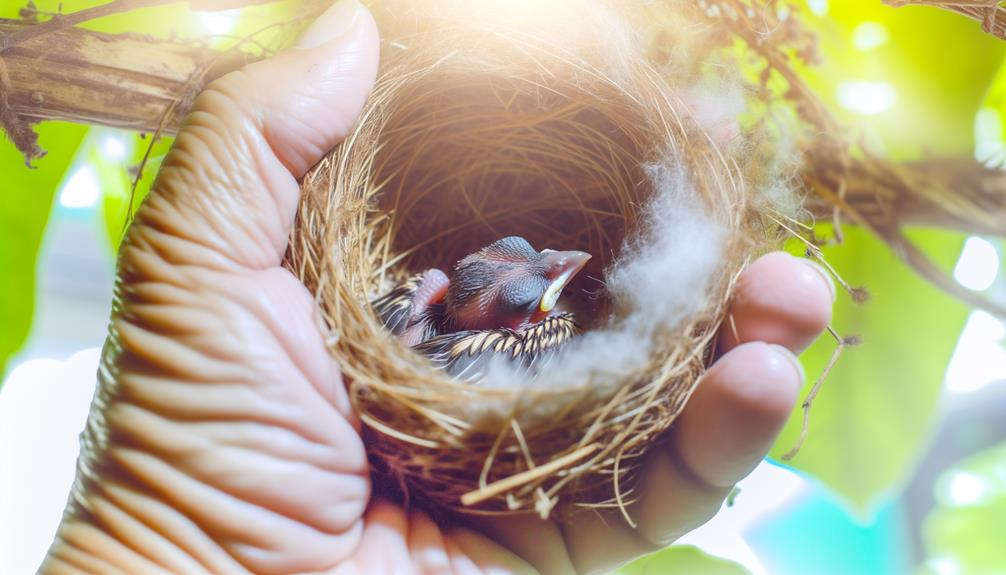
To guarantee the baby sparrow opens its mouth, you need to focus on providing proper heating methods. Maintain an ideal temperature range of 95-100°F using a heat lamp or heating pad.
Monitor the temperature closely with a reliable thermometer to prevent overheating or underheating.
Proper Heating Methods
Securing the baby sparrow's proper warmth involves using a heating pad or a well-regulated heat lamp to replicate the warmth it would naturally receive from its surroundings.
Position the heating pad beneath half of the box or container, allowing the bird to move if it becomes too warm.
Alternatively, use a heat lamp, making sure it's securely fixed at a safe distance.
- Heating Pad: Place it under half of the container.
- Heat Lamp: Secure it at a safe distance.
- Temperature Monitoring: Use a thermometer to guarantee consistent warmth.
- Insulation: Add soft cloths to preserve heat.
- Ventilation: Ensure proper airflow to avoid overheating.
Ideal Temperature Range
Maintaining an ideal temperature range of 95-97°F is essential for the baby sparrow's survival and well-being. To achieve this, you'll need a reliable heat source like a heating pad or infrared lamp.
Place the baby sparrow in a small container lined with soft cloth and position the heat source to maintain the desired temperature. Use a digital thermometer to monitor the heat closely, ensuring it remains within the 95-97°F range.
Remember, overheating can be just as harmful as underheating. Regularly check the sparrow's behavior; if it's too warm, it may pant or spread its wings. Adjust the heat source accordingly to maintain a stable environment conducive to feeding and recovery.
Your vigilance can literally save a life.
Use Gentle Stimulation
Gently tapping the side of the baby sparrow's beak with a soft, small object, such as a paintbrush or your fingertip, can encourage it to open its mouth. This technique mimics the natural feeding cues the parent birds provide.
To ensure effectiveness and safety, follow these detailed steps:
- Consistency: Apply gentle taps at regular intervals to establish a predictable pattern.
- Pressure: Use minimal force to avoid causing distress or injury to the delicate beak.
- Timing: Perform the tapping during daylight hours when the sparrow is more alert and responsive.
- Environment: Maintain a quiet, calm setting to minimize stress and distractions.
- Observation: Monitor the sparrow's reactions closely to adjust your approach as needed.
These steps are essential for successfully stimulating the sparrow's feeding response.
Offer Appropriate Food
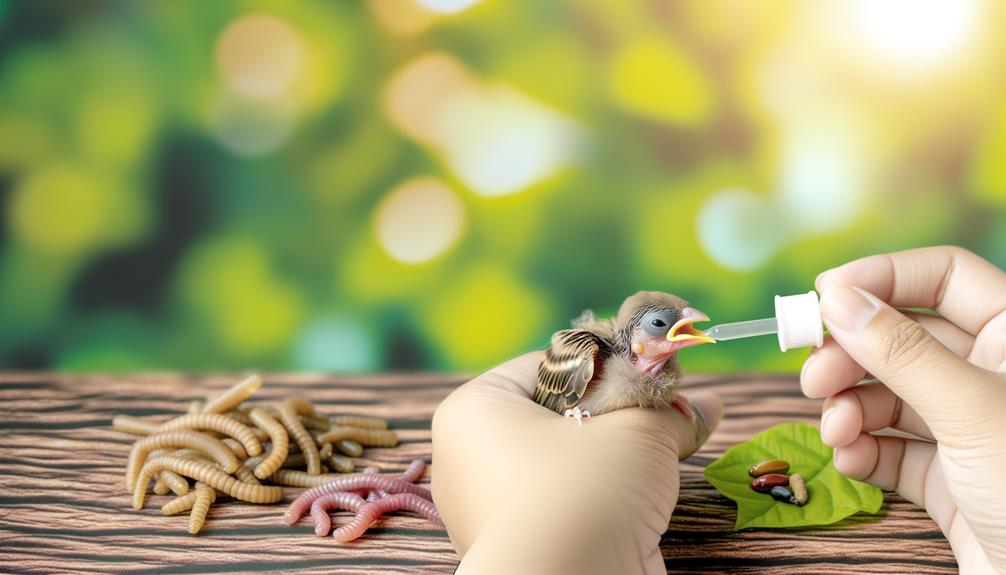
Selecting the right type of food for a baby sparrow is crucial for its growth and development. Careful consideration of its nutritional needs and the consistency of the food offered is essential. You should provide a diet rich in protein, such as soaked cat kibbles or specialized baby bird formula, as these mimic the nutrients found in their natural diet.
Make sure the food is soft and moist, as baby sparrows can't swallow solid food easily. Use a small, sterilized dropper or syringe to offer the food, ensuring it's at room temperature. Avoid feeding milk or bread, as these can cause digestive issues.
Proper food selection supports the sparrow's health and encourages it to open its mouth willingly.
Monitor Feeding Progress
To effectively monitor feeding progress, you should track the sparrow's feeding schedule meticulously, ensuring consistency and adequacy.
Regularly record the bird's weight to detect healthy growth patterns or identify potential issues.
Additionally, observe any behavioral changes that could indicate nutritional deficiencies or overfeeding.
Track Feeding Schedule
Regularly documenting the feeding times and amounts will help you make sure that the baby sparrow is receiving the proper nutrition for its growth and development. Consistent tracking is pivotal for adjusting feeding regimens based on the sparrow's needs. Use a logbook or a digital app to keep detailed records.
- Feeding time: Note the exact time of each feeding session.
- Amount fed: Record the quantity of food given in milliliters or grams.
- Type of food: Specify the type of food provided, whether it's a commercial mix or homemade formula.
- Behavioral notes: Observe and document the sparrow's response to feeding.
- Health indicators: Track any changes in health or unusual behaviors.
Record Weight Gain
Weigh the baby sparrow daily at the same time to accurately monitor its growth and make sure it's receiving adequate nutrition. Use a precision gram scale for the most accurate results. Record the weight in a log, noting any fluctuations or trends.
Consistent weight gain is a positive indicator of proper nutrition and health. If you observe stagnation or loss in weight, reassess the feeding schedule and food quality. Calculate the average daily weight gain to track progress effectively. Aim for consistent increments, as rapid changes could signal health issues.
Regular, detailed weight tracking guarantees the sparrow's developmental needs are met, fostering its growth into a healthy adult. Always handle the sparrow gently to avoid stress.
Observe Behavioral Changes
Carefully observe the baby sparrow's behavior during feeding to gauge its health and appetite accurately. Monitoring these behavioral changes is essential to guarantee the sparrow receives adequate nutrition and thrives.
- Check if the sparrow opens its beak readily when you approach with food.
- Note any changes in vocalizations, as increased chirping may indicate hunger.
- Observe the frequency and vigor of wing flapping, which can signal excitement or distress.
- Watch for signs of lethargy or disinterest in food, which may indicate illness.
- Monitor the consistency and color of droppings; abnormal droppings can indicate digestive issues.
Conclusion
By carefully evaluating the baby sparrow's condition and creating a safe, warm environment, you've laid the foundation for success.
Gentle stimulation and providing suitable food are your keys to open this delicate beak.
Monitor the feeding progress closely, as every small morsel counts.
Through patience and accuracy, you'll nurture this fragile life, transforming it from a silent whisper to a chirping proof of your care.
Your dedication can turn a challenging task into a symphony of survival.





